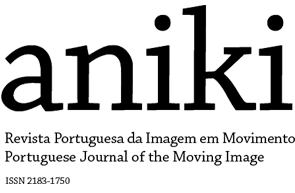Modernist Ruins, Filmic Archaeologies. Jane and Louise Wilson’s 'A Free and Anonymous Monument'
DOI:
https://doi.org/10.14591/aniki.v2n1.145Keywords:
Jane and Louise Wilson, A Free and Anonymous Monument, Victor PasmoreAbstract
Translation of the text originally published in Bruno, Giuliana. 2007. “Modernist Ruins, Filmic Archaeologies. Jane and Louise Wilson’s A Free and Anonymous Monument.” In Public Intimacy: Architecture and the Visual Arts, 43-86. Cambridge: MIT Press.References
Baudelaire, Charles (1993). O pintor da vida moderna, trad. Teresa Cruz. Lisboa: Vega.
Bowness, Alan (1980). “Introduction,” in Victor Pasmore: With a Catalogue Raisonné of Paintings, Constructions and Graphics, 1926–1979, ed. Alan Bowness and Luigi Lambertini, 9-17, London: Thames and Hudson.
Burnham, Nigel, and David Harrison. 2000. “Sixties 'concrete bungle' sculpture to be scrapped.” The Sunday Telegraph, July 16.
Bruno, Giuliana. 2002. Atlas of Emotion: Journeys in Art, Architecture, and Film. London: Verso.
Corrin, Lisa. 1999. “In Stereoscopic Vision: A dialogue between Jane & Louise Wilson and Lisa Corrin,” in Jane & Louise Wilson: Stasi City, Gamma, Parliament, Las Vegas, Graveyard Time, ed. Lisa Corrin, 6-15. London: Serpentine Gallery.
Eisenstein, Sergei. 1989. “Montage and Architecture,” Assemblage 10: 111–131.
Giedion, Sigfried. 1962. Space, Time and Architecture. Cambridge: Harvard University Press.
Giedion, Sigfried. 1969. Mechanization Takes Command. New York: Norton.
Kern, Stephen. 1983. The Culture of Time and Space, 1880–1918. Cambridge: Harvard University Press.
Le Corbusier. 1964. Oeuvre complète, vol. 2. Edited by Willi Boesiger. Zurich: Editions Girsberger.
Lee, Pamela M. 1999. Objects to Be Destroyed: The Work of Gordon Matta-Clark. Cambridge: MIT Press.
Millar, Jeremy and Claire Doherty. 2000. Jane and Louise Wilson. London: Film and Video Umbrella.
Robbins, David, ed. 1990. The Independent Group: Postwar Britain and the Aesthetics of Plenty. Cambridge: MIT Press.
Riegl, Alois. 1985. Late Roman Art Industry [1901], trans. Rolf Winkes. Rome: Giorgio Bretschneider Editore.
Riegl, Alois. 1993. Problems of Style: Foundations for a History of Ornament (1893), trans. Evelyn Kain. Princeton: Princeton University Press.
Schjeldahl, Peter. 1999. “V.I.: Jane & Louise Wilson,” in Jane & Louise Wilson: Stasi City, Gamma, Parliament, Las Vegas, Graveyard Time, ed. Lisa Corrin, 4-5. London: Serpentine Gallery.
Polidori, Robert. 2003. Zones of Exclusion: Pripyat and Chernobyl. Göttingen: Steidl.





